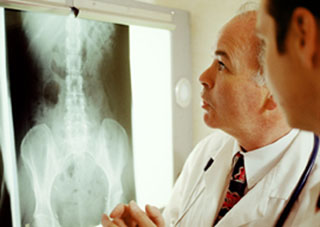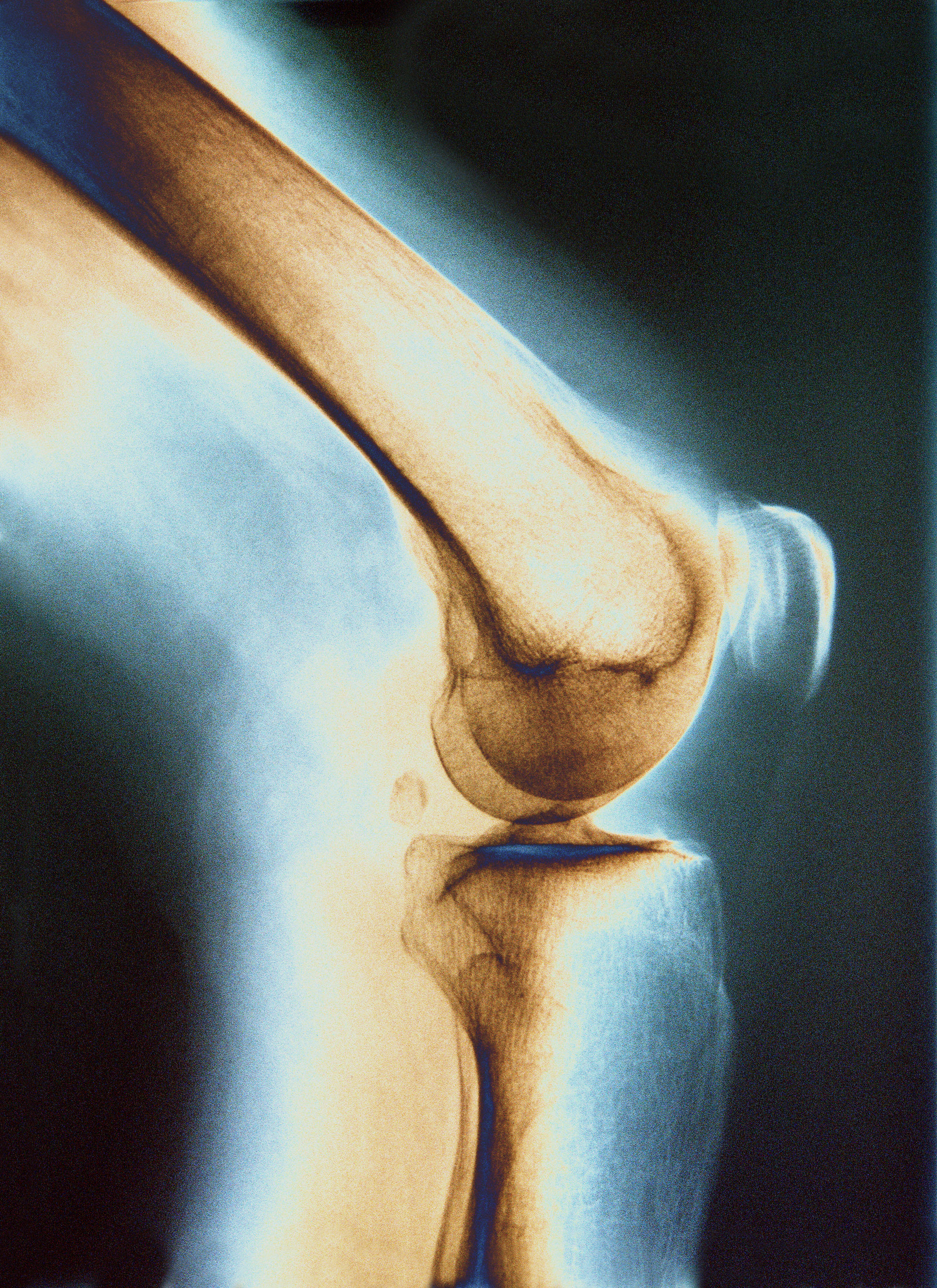Glucosamine
Effective treatment of osteoarthritis with glucosamine

Glucosamine - always with sulfate
It is vital that glucosamine is always combined with sulfur (as glucosamine sulfate), whether you take it as a dietary supplement or as a pharmaceutical drug. Sulfur ensures that glucosamine is effectively transported into the articular cartilage. In the United States there seems to be a tradition for attaching glucosamine to hydrochloride which does not contain sulfur, yet in scientific studies there is a significant difference between glucosamine sulfate and glucosamine hydrochloride. Glucosamine sulfate is without discussion a superior form.
Some patients use the sulfur compound MSM (methylsulfonylmethane) along with glucosamine, but this is only necessary if you take glucosamine hydrochloride. Like MSK, sulfate is a sulfur compound and both are equally effective when combined with glucosamine.
Effect of glucosamine sulfate
Glucosamine sulfate is the most used glucosamine salt. Although glucosamine's mechanism of action in the body is not fully understood, several scientific studies have shown a symptomatic effect of glucosamine on osteoarthritis symptoms. Glucosamine appears to have a number of useful properties. It has a slight anti-inflammatory effect and an indirect pain-relieving effect, as well. After two weeks of daily use, glucosamine has been shown to be every bit as pain-relieving as the NSAID-preparation ibuprofen. Glucosamine sulfate prevents further deterioration of joint cartilage and is even believed to have tissue-regenerating properties, but without clear evidence showing that it can actually restore lost cartilage. Some of the effects are attributed to the sulfur content. Glucosamine sulfate is the only known substance that holds all of these combined properties. Pain relief comes only after several weeks of administration / treatment, in some cases even longer.
Chondroitin
Chondroitin is a so-called muco polysaccharide (organic sugar compound). Like glucosamine, chondroitin is a natural component of cartilage, which the body can make itself. It reduces fluid loss from the cartilage matrix and inhibits enzymatic degradation of the existing cartilage. Chondroitin supplements are used as preventative and supportive treatment of damage and degradation of connective tissue, cartilage, skin, tendons and ligaments. Chondroitin is non-toxic even at high doses.
What is glucosamine?
Glucosamine is a relatively small molecule. It is an amino- monosaccharide or, put more simply, an organic, water-soluble sugar compound that occurs naturally in the body's cartilage.
Glucosamine is necessary for the formation of the cartilage ground substance that is composed mainly of chain-shaped molecules called glucosaminoglycans.
These glycans increase the elasticity of cartilage and its ability to absorb shock, a property which is of great practical importance to the cartilage included in our joints. Normally, the body is able to produce glucosamine sufhate by linking glucose to the amino acid glutamine and sulfur, but this capacity is limited. A glucosamine supplement will therefore help increase the production of these major cartilage molecules.
Glucosamine stimulates the cartilage cells to form these glucosaminoglycans, which make the cartilage more elastic and shock-resistant. The glucosamine used in most commercial glucosamine products is obtained from chitin from shellfish, especially shrimp. Chitin is not to be confused with keratin which is the key structural component of the outer layer of human skin and of hair and nails.
Different glucosamine salts
Glucosamine supplements never contain pure glucosamine. Instead, various glucosamine salts are used, primarily glucosamine sulfate and, to a lesser degree, glucosamine hydrochloride. There is even such a thing as glucosamine sulfate based on glucosamine derived from corn plants.
In addition, glucosamine sulfate salts differ from each other in that some are stabilized with sodium chloride and others with potassium chloride. Again, this may influence their effect.
Some people already get too much salt (sodium chloride) in their diet. Too much sodium raises blood pressure and increases the excretion of calcium in the urine. Potassium, on the other hand, helps to lower blood pressure and boosts muscles and nerves. We must remember that users of glucosamine are typically older people, some of whom have high blood pressure and weakened bones.
The significance of sulfur
In any case, when the glucosamine salts are ingested and react with the gastric juice, the glucosamine is detached, regardless if it is attached to sulfate (sulfur) or hydrochloride. This does not mean that the sulfur source is irrelevant in this context. We know that sulfur is essential for the formation of cartilage and connective tissue. In addition, sulfur inhibits enzymes such as serine protease and collagenase which break down cartilage. Some researchers even contain that sulfur mediates the therapeutic effect of glucosamine, at least to some extent.
It is also worth noting that the sulfur content in cartilage is reduced in elderly people, which increases their need for this compound.
Absorption of glucosamine
The absorption of glucosamine from the small intestine is good, with approx. 80-90% being absorbed. Some is broken down in the liver, while the rest is transported into the cartilage. However, the absorption from the blood and into the cartilage is poor. This is because the cartilage does not contain blood vessels. Instead, the absorption here takes place by means of passive diffusion (a movement of biochemical and other molecular substances across cell membranes). This mechanism is not particularly efficient.
Research has shown how glucosamine from tablets can be found in the cartilage a few hours after ingestion, but it takes at least two weeks for an apparent effect of glucosamine supplementation to show. In some cases it takes even longer, perhaps up to three months.
To determine if glucosamine has an effect, you need to take it every day for 8-12 weeks. If there is no relief of symptoms after supplementing for this period, you may not be likely to benefit from glucosamine. Some people don't notice the effect of glucosamine until after they stop taking, simply because it takes such a long time for the substance to work.
Best for knee and hip joints

Glucosamine molecules move into the cartilage from an area of high concentration (blood) to an area of low concentration (cartilage) without the need for active assistance.
Healthy joints
In a young and healthy knee joint, the intact cartilage layer serves as a protective cushion for absorbing shock and impact. The best way to maintain healthy cartilage is to stimulate the joint with regular exercise. Nutrients enter the cartilage by means of the previously described alternating compression and decompression of the cartilage tissue that takes place, for example when we walk and run. These nutrients serve as building blocks for the construction and maintenance of strong and elastic cartilage. Inactive joints, in comparison, receive much less nutrition.
Obesity reduces the effect
Osteoarthritis is listed as a disease with very large symptom variation. Many will benefit from supplementing with glucosamine, but not everyone. Overweight is one factor that reduces the effect of glucosamine. Overweight knee osteoarthritis sufferers can only expect positive results from glucosamine supplements if they lose weight.
Severe osteoarthritis is another limiting factor. In these cases one cannot expect benefits from glucosamine. Once all the cartilage is gone, there are no cells left to utilize the added glucosamine. However, there is good evidence glucosamine supplements work on patients with mild to moderate osteoarthritis.
Dosage of glucosamine
The most convincing results have been observed with 1500 mg of glucosamine sulfate daily in subjects with mild to moderate osteoarthritis. In research and clinical practice, this is a standard dosage. There is no time limit to intake, and the dosage should not be lowered once it starts to show signs of benefit. Normally, glucosamine supplementation is a lifelong procedure.
Severely overweight people may need a higher dose of glucosamine sulfate than the recommended 1500 mg per day. They can take a daily dose of up to 20 mg of glucosamine sulfate / kg of body weight even if weight loss is required. Some may experience mild gastrointestinal symptoms which are often remedied by taking the glucosamine supplement with a meal.
4/5 of glucosamine sulfate consists of pure glucosamine, so if you have 500 mg of glucosamine sulfate, approximately 400 mg are pure glucosamine.
When should you avoid glucosamine?
If you are allergic (hypersensitive) to glucosamine or one of its components, or if you have a shellfish allergy you should not take glucosamine, as the active substance is derived from shellfish.
Because there are no scientific studies of glucosamine on pregnant and lactating women, it is recommended not to use take glucosamine supplements during pregnancy and lactation.
Side effects
Only few and insignificant side effects have been reported with glucosamine use. These include constipation, diarrhea, nausea, headache, fatigue and itching. Incidentally, the very same side effects are seen among study participants in control groups who are given inert placebo pills.
Cholesterol levels
There are a few reported cases of increased total and LDL cholesterol values in patients after treatment with glucosamine for up to one year. These temporary elevations dropped again, once the glucosamine supplementation was discontinued. The Danish Medicines Agency has estimated that these side effects are nothing to be concerned about.
Blood sugar and diabetics
There has been speculation about whether glucosamine could affect the body's blood sugar levels and lead to insulin resistance, a condition where insulin's ability to clear sugar from the bloodstream is reduced. There is not much evidence to support that. In a 3-year trial, four participants developed type 2 diabetes, but three of them were in the control group that did not receive glucosamine. Another 2004 study found no negative impact. Even people with well-controlled diabetes can take glucosamine, but diabetics are advised to monitor their blood glucose levels extra carefully when taking glucosamine.
What is osteoarthritis?
Osteoarthritis is also called degenerative arthritis. It is a chronic joint disease that can affect any joint, but most often it affects the spine, knees, hips, outer joint of the finger and the big toe phalangeal. In osteoarthritis, the articular cartilage gradually deteriorates. People with osteoarthritis frequently complain about pain, tenderness and restricted movement in the affected joints. In many cases, inflammation arises around the affected joints, contributing to a worsening of the symptoms. In some cases the joint makes cracking or crunching noises. Not all osteoarthritis sufferers experience the same symptoms, which can make it difficult to make a diagnosis. Some have constant pain, while others only experience occasional pain.
Special attention is required in the case of
- Impaired renal function and / or potassium-deficient diet
- Diabetes: Check your blood sugar regularly when taking glucosamine
- Asthma
- Concomitant use of certain drugs - especially blood thinners (warfarin) and antibiotics (tetracyclines)
Not always due to wear and tear
Osteoarthritis can have several causes and is not necessarily a result of wear and tear. Osteoarthritis of the knee is more common among people who strain their knees or have a history of knee injuries. Elite athletes and people with hard manual labor such as e.g. floor layers, movers and transport workers who burden their knees for prolonged periods of time are at increased risk. However, there are plenty of exceptions where hard work and elite sports have not lead to osteoarthritis. Perhaps, it is more appropriate to speak of an increased risk.
Statistics show that eight out of ten people older than 50 years of age suffer from osteoarthritis of some degree. Part of this is down to an age-related deterioration of articular cartilage caused by enzymes. Osteoarthritis can also be caused by factors such as e.g. obesity, genetic conditions, overloading of the joints and poor posture. In many cases, however, the cause is unknown.
Exercise and osteoarthritis
Muscle tissue that is not used tends to waste away. This is a known problem of osteoarthritis, where strong muscles are needed to help protect the joints by keeping them in place. Unstable joints alone can lead to the development of osteoarthritis. Therefore, exercise and weight training is important, both in terms of prevention and for avoiding exacerbation of existing osteoarthritis. Many people with osteoarthritis refrain from exercise, simply because of the pain. Actually, they would be better off with regular exercise.
Osteoarthritis is a public disease that becomes increasingly common with age. Women seem to be affected slightly more than men and in different joints. Women more often develop osteoarthritis of the knees, while men tend to develop osteoarthritis in the hips. Although osteoarthritis is not always painful, it is a major cause of impaired quality of life.
What can be done?
Contrary to common belief, it seems that regular exercise such as e.g. cycling can reduce the risk of developing osteoarthritis. If you are overweight, weight loss is bound to help, as this reduces the load on the knee joints. In severe cases of osteoarthritis, joint replacement surgery may be considered.
Refs.
Houpt JB, et al. J Rheumatol 1999.
Braham R, et al. Br J Sports Med 2003
Rindone JP, et al. West J Med. 2000
Hughes R, Carr A. Rheumatology 2002.
- Created on .












 "After about one week of taking the Q10 supplement I could feel a huge difference," says 23-year old Alan Piccini, who has been suffering from extreme fatigue and muscle aches ever since he was a child.
"After about one week of taking the Q10 supplement I could feel a huge difference," says 23-year old Alan Piccini, who has been suffering from extreme fatigue and muscle aches ever since he was a child. “Taking capsules with co-enzyme Q10 has freed me of the severe side effects of my cholesterol lowering medicine,” Mrs Franken explains.
“Taking capsules with co-enzyme Q10 has freed me of the severe side effects of my cholesterol lowering medicine,” Mrs Franken explains.